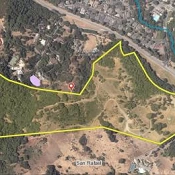 photo credit: https://www.flickr.com/photos/34186459@N00/
photo credit: https://www.flickr.com/photos/34186459@N00/Black Mountain & Nicasio Reservoir in West Marin.
Marin County's water supply could get a healthy boost during wet years if a pipeline project initiated this week by the Marin Municipal Water District Board comes to fruition.
On Tuesday, the board voted to approve a contract for design and engineering work on the Atmospheric River Capture Project, or ARC.
"In the 2021 drought our reservoir levels went really low, so we've spent the last four years doing a strategic water supply assessment," said Lucy Croy, water quality manager for the district.
During the drought, and with only about six months of water left in its reservoirs, the district began to focus on ways to improve water storage capacity, conservation, groundwater banking and, among other things, bringing in additional supplies from the Russian River.
The plan is to build a 36-inch-wide pipeline running a little more than 13 miles from the existing North Marin Aqueduct to Marin Water's Nicasio Reservoir.
The North Marin Aqueduct was built in the 1970s and primarily supplies water from the Russian River in Sonoma County to Novato and environs, but it has also been a supplemental source for Marin Water over the years.
The idea now is to capture up to roughly 3,800 acre feet of water from the Russian River during big storm events, pump it through the aqueduct and the new pipeline connection and into Nicasio Reservoir, which is one of seven reservoirs supplying drinking water to 191,000 people in central and southern Marin County.
An acre foot of water is enough to supply two or three homes for a year.
"The watershed is so much larger in the Russian River," Croy said. "When we look back on historic data, even in the driest of years, there's still a large volume that flows out to the ocean that is still above any instream flow requirements -- it's water that's more or less lost to the ocean."
Currently, Marin Water gets most of its supply from rainfall in the Mt. Tam watershed area and is unable to connect to the state's two large water storage and conveyance systems -- the federally operated Central Valley Project and California's State Water Project.
The district's ARC project includes the pipeline and a new pumping plant and is estimated at $167 million, including the recently approved $9.7 million design and engineering phase.
"The ideal plan at this point is to work through the design and environmental review over the next two years," Croy said, adding that if all goes well, the project could be up and running by sometime in 2029.
Much of the work will be paid for using bonds, but that shouldn't lead to water price increases for district customers.
"The debt service for the bonds is built into our current rate structure, so we don't anticipate any rate increases due to this," Croy said.
The board will still need to vote publicly on different aspects of the project, including on the selection of a consultant to do the environmental review and then again to accept that work once it's complete.
If it wins final approvals from the board, the project would mark the district's largest water supply project since the early 1980s, when it raised the level of Kent Dam.

 Live Radio
Live Radio









